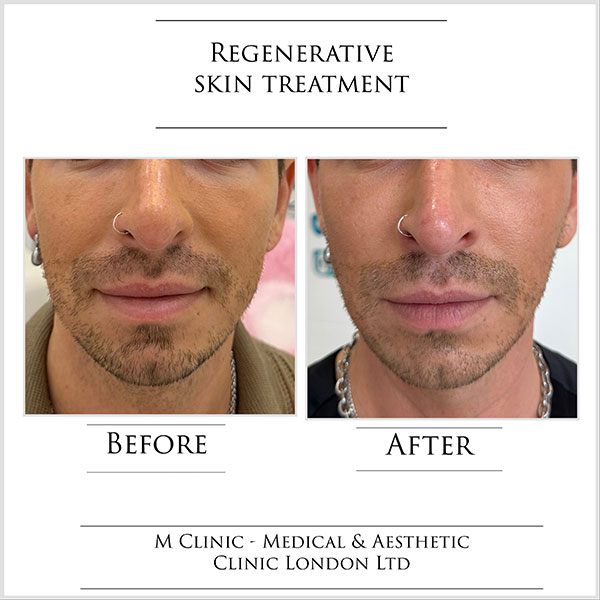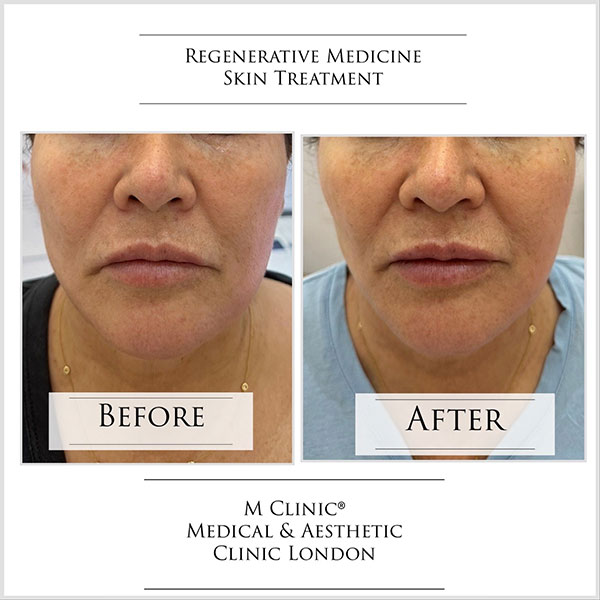Regenerative Treatments – Polynucleotides
What are Polynucleotides?
Polynucleotides are long chains of nucleotides, the fundamental building blocks of DNA and RNA. In the field of aesthetic medicine, polynucleotides are used to rejuvenate and revitalize the skin. This is an innovative treatment promoting skin healing, encouraging collagen synthesis, and enhancing skin rejuvenation.
Benefits of Polynucleotides
Polynucleotides stimulate collagen synthesis, encouraging the skin to produce new collagen and elastin. This helps restore skin firmness, improve skin texture, and minimize the appearance of fine lines and wrinkles. Polynucleotides may also enhance DNA repair in the skin, protect cells from UV-induced DNA damage, and reduce the need for internal repairs. They promote skin healing and regeneration, increase skin hydration and moisture retention, and help reduce pigmentation and scarring.


When will I see results after Polynucleotide treatment?
Do Polynucleotides help with pigmentation spots on the skin?
Is Polynucleotide treatment effective for Rosacea?
How many treatments are required?
What are the side effects of Polynucleotide treatment?
What is the difference between Polynucleotides and Dermal Fillers?
What are Polynucleotides?
Plenhyage XL, then the strongest concentration of Polynucleotides, functions as an anti-free radical agent, neutralizing hydroxyl radicals (OH) that accumulate due to stress, cell damage, and exposure to UV rays. This activity boosts the production of fibroblasts, cells essential for tissue repair and elasticity. Clinical research indicates that polynucleotides also stimulate the generation of myofibroblasts.
Polynucleotides activate fibroblasts and stem cells, thereby enhancing the body’s natural ability to regenerate skin cells through a natural healing process. This results in improved skin texture, tone, and elasticity. Additionally, polynucleotides possess anti-inflammatory properties that help reduce redness and scarring. Their excellent hydrating properties improve dry, dehydrated, or dull skin by attracting and retaining moisture, thereby reducing the appearance of fine lines and wrinkles. The skin becomes more plump and smooth, showing fewer signs of environmental damage and ageing. The procedure involves injecting small amounts of polynucleotides into the skin using fine needles.
Polynucleotide treatments are generally minimally invasive and well-tolerated, making them an excellent option for skin rejuvenation without significant downtime or side effects.
Author:

Dr Margaret Grabicka
General Medicine and Aesthetic Medicine Doctor with expert experience in anti-ageing procedures, dermal fillers, anti-wrinkle injections, i.v infusions, lifting threads and body contouring treatments.
Polynucleotides
What are Polynucleotides?
Polynucleotides are long chains of nucleotides, the fundamental building blocks of DNA and RNA. In aesthetic medicine, polynucleotides are used to rejuvenate and revitalize the skin. This is an innovative treatment promoting skin healing, encouraging collagen synthesis, and enhancing skin rejuvenation.
Plenhyage XL, then the strongest concentration of Polynucleotides, functions as an anti-free radical agent, neutralizing hydroxyl radicals (OH) that accumulate due to stress, cell damage, and exposure to UV rays. This activity boosts the production of fibroblasts, cells essential for tissue repair and elasticity. Clinical research indicates that polynucleotides also stimulate the generation of myofibroblasts.
Polynucleotides activate fibroblasts and stem cells, thereby enhancing the body’s natural ability to regenerate skin cells through a natural healing process. This results in improved skin texture, tone, and elasticity. Additionally, polynucleotides possess anti-inflammatory properties that help reduce redness and scarring. Their excellent hydrating properties improve dry, dehydrated, or dull skin by attracting and retaining moisture, thereby reducing the appearance of fine lines and wrinkles. The skin becomes more plump and smooth, showing fewer signs of environmental damage and ageing. The procedure involves injecting small amounts of polynucleotides into the skin using fine needles.
Polynucleotide treatments are generally minimally invasive and well-tolerated, making them an excellent option for skin rejuvenation without significant downtime or side effects.
What are the benefits of Polynucleotides?
Polynucleotides stimulate collagen synthesis, encouraging the skin to produce new collagen and elastin. This helps restore skin firmness, improve skin texture, and minimize the appearance of fine lines and wrinkles. Polynucleotides may also enhance DNA repair in the skin, protect cells from UV-induced DNA damage, and reduce the need for internal repairs. They promote skin healing and regeneration, increase skin hydration and moisture retention, and help reduce pigmentation and scarring.
When will I see the results after Polynucleotide treatment?
The first signs of improvement appear 7 to 10 days post-treatment, with full effects visible three to four weeks later. This is the recommended time frame for your second and subsequent treatments.
Do Polynucleotides help with pigmentation spots on the skin?
Yes, polynucleotides have shown effectiveness in reducing hyperpigmentation such as age spots, sunspots, and melasma. They work by inhibiting melanin production, the pigment responsible for dark spots, which helps fade existing pigmentation and prevent the appearance of new spots, thereby improving skin tone.
Is Polynucleotide treatment effective for Rosacea?
Activation of the A2A receptor by polynucleotides is associated with tissue regeneration and anti-inflammatory effects, making it ideal for individuals with rosacea.
How many treatments are required?
For optimal, long-lasting results, it is advisable to follow a protocol of two or three subsequent treatments at intervals of three weeks to one month. The specifics can be discussed with your doctor during the initial consultation.
What are the side effects of Polynucleotide treatment?
Side effects may include mild redness, tenderness, swelling, or itching during and immediately following the procedure. These symptoms are temporary and usually subside within a few hours. There is a small risk of post-treatment bruising at injection sites, but this is typically minimal and superficial. As a minimally invasive, non-surgical procedure, you can generally resume your daily activities immediately after the session.
What is the difference between Polynucleotides and Dermal Fillers?
Unlike hyaluronic acid in dermal fillers, which plumps up the injected area immediately, polynucleotides function differently by stimulating cellular regeneration over time. They enhance the metabolic activity of skin cells by revitalizing and rejuvenating tired, aged, and damaged cells.
